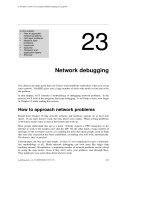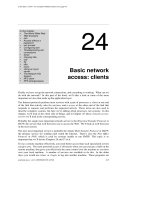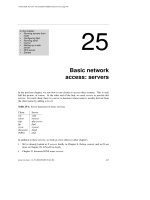Chapter 08 network troubleshooting
Bạn đang xem bản rút gọn của tài liệu. Xem và tải ngay bản đầy đủ của tài liệu tại đây (2.75 MB, 72 trang )
Chapter 8: Network Troubleshooting
CCNA Exploration 4.0
2
Objectives
•
Establish and document a network baseline.
•
Describe the various troubleshooting methodologies and
troubleshooting tools.
•
Describe the common issues that occur during WAN
implementation.
•
Identify and troubleshoot common enterprise network
implementation issues using a layered model approach.
3
Establishing the
Network Performance Baseline
4
Documenting Your Network
•
To efficiently diagnose and correct network problems, a
network engineer needs to know how a network has been
designed and what the expected performance for this
network should be under normal operating conditions. This
information is called the network baseline.
•
Network documentation should include these components:
–
Network configuration table
–
End-system configuration table
–
Network topology diagram
5
Network configuration table
•
Contains accurate, up-to-date records of the hardware and
software used in a network.
6
End-system Configuration Table
•
Contains baseline records of the hardware and software
used in end-system devices such as servers, network
management consoles, and desktop workstations.
7
Network Topology Diagram
•
Graphical representation of a network, which illustrates how
each device in a network is connected and its logical
architecture.
8
Documenting Your Network
9
Network Documentation Process
•
When you document your network, you may have to gather
information directly from routers and switches. Commands
that are useful to the network documentation process
include:
–
The ping command
–
The telnet command
–
The show ip interface brief command
–
The show ip route command
–
The show cdp neighbor detail command
10
Documenting Your Network
11
Why Is Establishing a Network Baseline Important?
12
Steps for Establishing a Network Baseline
•
Planning for the First Basline
•
Step 1. Determine what types of data to collect
13
Steps for Establishing a Network Baseline
•
Step 2. Identify devices and ports of interest
14
Steps for Establishing a Network Baseline
•
Step 3. Determine the baseline duration
It is important that the length of time and the baseline
information being gathered are sufficient to establish a
typical picture of the network.
15
Steps for Establishing a Network Baseline
Measuring Network Performance Data
•
Automated Data Collection: Fluke Network SuperAgent
module
16
Steps for Establishing a Network Baseline
Measuring Network Performance Data
•
Manual Commands
17
Troubleshooting Methodologies and
Tools
18
A General Approach to Troubleshooting
•
Network engineers, administrators, and support personnel
realize that troubleshooting is a process that takes the
greatest percentage their time.
•
Two extreme approaches to troubleshooting almost always
result in disappointment, delay, or failure.
–
The theorist, or rocket scientist, approach
–
The impractical, or caveman, approach.
•
The rocket scientist: analyzes and
reanalyzes the situation until the exact
cause at the root of the problem has
been identified and corrected with
surgical precision.
19
A General Approach to Troubleshooting
•
The caveman: first instinct is to start
swapping cards, cables, hardware, and
software until miraculously the network
begins operating again.
•
Since both of these approaches are
extremes, the better approach is
somewhere in the middle using elements
of both. It is important to analyze the
network as a whole rather than in a
piecemeal fashion. A systematic
approach minimizes confusion and cuts
down on time otherwise wasted with trial
and error.
20
Using Layered Models for Troubleshooting
•
OSI Versus TCP/IP Layered Models
21
General Troubleshooting Procedures
•
General troubleshooting process:
22
Troubleshooting Methods
•
There are three main methods for troubleshooting networks:
–
Bottom up
–
Top down
–
Divide and conquer
•
Bottom-Up Troubleshooting Method
–
Good approach to use when the
problem is suspected to be a
physical one.
–
Disadvantage: requires checking
every device and interface
until the possible cause of the
problem is found.
23
Troubleshooting Methods
•
Top-Down Troubleshooting Method
–
Use for simpler problems or when
you think the problem is with a piece
of software.
–
Disadvantage: requires checking
every network application until the
possible cause of the problem is
found.
•
Divide-and-Conquer Troubleshooting
Method
–
You select a layer and test in both
directions from the starting layer.
24
Troubleshooting Methods
•
Guidelines for Selecting a Troubleshooting Method
25
Gathering Symptoms
•
Step 1. Analyze existing
symptoms
•
Step 2. Determine
ownership
•
Step 3. Narrow the scope
•
Step 4. Gather symptoms
from suspect devices
•
Step 5. Document
symptoms









